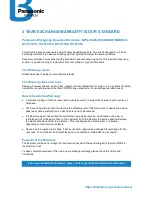
18
MPS4232
Section 3: Operation
TCP client. Programs like ScanTel, HyperTerminal, or PuTTY
can be used to display and collect the ASCII data to the
screen or to a file. If binary data output is not enabled, and
command is sent to the Telnet port, the MPS will
typically return data to the host from where the command
was sent.
ASCII data can be formatted using the
FORMAT
variable
under
. The three formats available are:
• Unformatted, column based (scrolling)
• Formatted, VT100 terminal style (updating)
• Comma Separated Variable, CSV (scrolling)
Data output follows the specified ASCII packet structure
listed in Section 5: Software.
Binary TCP Scan Data Transfer
The MPS4200 provides a binary TCP server designed to
support any computer based TCP client, such as LabVIEW.
The structure of the binary packet sent from the binary
server is expressed in Section 5: Software
The Binary TCP server expects a connection to arrive on
port 503. Data will only stream to a single connection. If a
second connection is opened on the port, data will send on
the new connection.
Because all configuration settings may be handled via the
Telnet server (port 23), the binary server supports starting
and stopping a scan with commands sent to port 503.
Sending the binary representation of the integer “1” will
start a scan, and sending the binary representation of the
integer “0” will stop the scan. The scanning will also stop if
the FPS variable has been met, the MPS scan buffer over
-
flows, or when the binary client disconnects from the MPS.
The scan still adheres to the variables configured in the
,
.
Scans can also be initiated use the SCAN command via
telnet, or an external scan trigger (TRIG == 2). When
these options are used, the connection to port 503 must
be opened prior to the SCAN command or external scan
trigger. If this connection is not made, the MPS will not
send scan data to this destination. The scanning will also
stop if the FPS variable has been met, the MPS scan buffer
overflows, or when the binary client disconnects from the
MPS. The scan still adheres to the variables configured in
, and
.
FTP Scan Data Transfer
The MPS4200 can transfer scan data using FTP protocol to
an applicable FTP server. The user may set up any suitable
server or NAS capable of running as a FTP server.
is set to one, and a scan is started, the soft
-
ware will attempt to connect and open a file on the FTP
server as configured by the FTP variables. The time and
date that is indicated by the
GETTIME
command is used in
the construction of the file name.
The file that is saved on the server is assembled as follows:
<path on server><base data filename><date>_<time>.<type>
Where <type> is:
• “.DAT” for binary
• “.TXT” for ASCII Text
• “.CSV” for ASCII CSV file.
The file is closed when the scan stops. If the file cannot
be opened on the server when the scan starts, the scan is
stopped before any data is output and the MPS will report
an error.
FTP protocol can be used simultaneously with UDP output.
This allows users to configure a system such that data can
be monitored “real-time” via the UDP stream and collected
reliably via the FTP data transfer. For more information on
FTP variables, please see Section 5: Software.
UDP Scan Data Transfer
The MPS4200 can transfer scan data using UDP protocol to
an applicable UDP client. The user may set up any suitable
UDP client for this operation. Data output follows the speci
-
fied packet structure listed in Section 5: Software.
UDP output supports a multicast address following the
standard UDP multicast address group, using a UDP address
of 224.0.0.0 through 239.255.255.255 and any valid port.
UDP protocol can be used simultaneously with FTP output.
This allows users to configure a system such that data can
be monitored “real-time” via the UDP stream and collected
reliably via the FTP data transfer. For more information on
UDP variables, please see Section 5: Software.
Binary Data Buffering
All binary data output, including the Binary server, can
buffer up to 32768 frames of data (using the standard 32
channel binary packet) before the buffer overflows and
stops scanning. This allows the host software to gather data
from the MPS at a slower rate than the MPS is scanning.
However, multiple frames must be read, at once, with each
read.
To calculate the maximum time that the client can wait
before reading data from the binary server use the
following:
Summary of Contents for MPS4232
Page 1: ...MPS4232 Miniature Pressure Scanner Hardware and Software Manual Software Version 1 00...
Page 2: ......
Page 3: ......
Page 6: ...INTENTIONALLY LEFT BLANK...
Page 12: ...6 MPS4232 Section 1 Specifications INTENTIONALLY LEFT BLANK...
Page 15: ...9 MPS4232 Section 1 Introduction Section 1 Specifications MPS4232 INTENTIONALLY LEFT BLANK...
Page 18: ...12 MPS4232 Section 2 Introduction INTENTIONALLY LEFT BLANK...
Page 33: ...27 MPS4232 Section 4 Hardware INTENTIONALLY LEFT BLANK...
Page 37: ...31 MPS4232 Section 5 Software INTENTIONALLY LEFT BLANK...
Page 51: ...45 MPS4232 Section 5 Software...
Page 81: ...75 MPS4232 Section 6 Maintenance INTENTIONALLY LEFT BLANK...
Page 90: ...84 MPS4232 Appendix INTENTIONALLY LEFT BLANK...
Page 94: ...88 MPS4232 Appendix D Software Revision Log Version 1 00 Initial Release...
















































